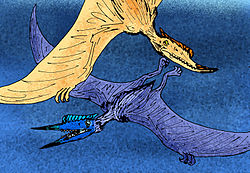ノリプテルス
この項目「ノリプテルス」は翻訳されたばかりのものです。不自然あるいは曖昧な表現などが含まれる可能性があり、このままでは読みづらいかもしれません。(原文:https://en.wiki.x.io/w/index.php?title=Noripterus&oldid=1023662261) 修正、加筆に協力し、現在の表現をより自然な表現にして下さる方を求めています。ノートページや履歴も参照してください。(2022年7月) |
ノリプテルス (Noripterus) は中国新疆ウイグル自治区ジュンガル盆地の連木沁累層(下部白亜系)から発見された翼指竜亜目ズンガリプテルス科翼竜の1属。学名はモンゴル語で「湖」を表す"nuur"とギリシャ語で「翼」を表すπτερόν (pteron) から「湖の翼」の意味である。本属は楊鍾健(ピン音表記ではYang Zhongjianであるが、それより古い記法ではYoung Chung Chienとして知られる)により1973年に命名された。さらなる化石がモンゴルのTsagaantsav累層から見つかっている。
| ノリプテルス | ||||||||||||||||||||||||||||||||||||
|---|---|---|---|---|---|---|---|---|---|---|---|---|---|---|---|---|---|---|---|---|---|---|---|---|---|---|---|---|---|---|---|---|---|---|---|---|
 ノリプテルスの復元図(下)上はズンガリプテルス
| ||||||||||||||||||||||||||||||||||||
| 保全状況評価 | ||||||||||||||||||||||||||||||||||||
| 絶滅(化石) | ||||||||||||||||||||||||||||||||||||
| 地質時代 | ||||||||||||||||||||||||||||||||||||
| 中生代前期白亜紀 | ||||||||||||||||||||||||||||||||||||
| 分類 | ||||||||||||||||||||||||||||||||||||
| ||||||||||||||||||||||||||||||||||||
| 学名 | ||||||||||||||||||||||||||||||||||||
| Noripterus Young, 1973 | ||||||||||||||||||||||||||||||||||||
| タイプ種 | ||||||||||||||||||||||||||||||||||||
| Noripterus complicidens Young, 1973 | ||||||||||||||||||||||||||||||||||||
| シノニム | ||||||||||||||||||||||||||||||||||||
|
Noripterus
N. parvus
| ||||||||||||||||||||||||||||||||||||
| 和名 | ||||||||||||||||||||||||||||||||||||
| ノリプテルス | ||||||||||||||||||||||||||||||||||||
| 種 | ||||||||||||||||||||||||||||||||||||
|
記載
編集ノリプテルスの最初に発見された模式標本(IVPP V.4062 模式地はIVPP 64045)は、頭骨の前部・下顎・脊椎・四肢の一部・骨盤が保存されていた。ノリプテルスは同時代に生存していたズンガリプテルスによく似ているが、大きさは2/3ほどである。頚椎は細長く、ズンガリプテルスと同じくトサカと前方に歯が無い下顎を持つ。歯は良く発達しており少し間隙を置いて生えている。鋭い口先は真っ直ぐで、ズンガリプテルスのように上方に反ってはいない[1]。
分類
編集ズンガリプテルスとの類似性から、ノリプテルスはズンガリプテルス科 (Dsungaripteridae) に置かれている[2]。
フォべトール属 (Phobetor) は、元々1982年にNatasha Bakhurinaが1本の下肢骨 (PIN 3953) を基にズンガリプテルス属の新種 Dsungaripterus parvus として記載したものである。後に、ほとんど完全な頭骨 (GIN 100/31) を含む多くの化石が発見されたことから、Bakhurinaは1986年にD. parvusを新しく設けた属であるPhobetor属に移し、種名をPhobetor parvusとした。しかし、Phobetorという属名はカジカ上科魚類の1種(英名:arctic staghorn sculpin、学名:Gymnocanthus tricuspis )の異名である"Phobetor tricuspis" Krøyer, 1844 として既に使用されており、そのため無効である。2009年に呂(Lü)等は既知のズンガリプテルス科化石標本の多くを再調査し、フォべトールとノリプテルスは区別不可能であり、フォべトールはノリプテルスの新参異名であるとした[3]。
それまでフォべトールとされていた標本がノリプテルスの物となったため、ノリプテルスの体サイズは増大し、最大翼開長の推定値は4 m となった[4]。
下記は2014年にAndres等によって発表された分岐分析の結果を示すクラドグラムである。彼らはノリプテルスをズンガリプテルス科の中の独自の亜科であるノリプテルス亜科 (Noripterinae) に置いた[5]。
| Dsungaripteromorpha |
| ||||||||||||||||||||||||||||||||||||
2019年に、異なるクラドグラムがケルナー等によって発表された。この研究ではノリプテルスはより大きなグループTapejaroideaの中でAzhdarchoideaの外側に置かれ、ズンガリプテルスと姉妹群をなすとされた。そのクラドグラムを以下に示す[6]。
| Tapejaroidea |
| ||||||||||||||||||||||||||||||||||||
古生物学と生態
編集ノリプテルスのようなズンガリプテルス類は、細長く歯の無い嘴先端を索餌や採餌に用い、後方にある頑丈な歯で外殻を割るようにして、貝類や甲殻類またはそれに類する硬い殻を持つ獲物を食べるのに適応していたと考えられている。ズンガリプテルス類の頭骨は他の翼竜よりも頑丈で、四肢や脊椎も同様である[7]。
ノリプテルスはより大型のズンガリプテルスと同時代同地域に生息しており、産出層は広大な内陸湖水系の存在を示唆している。ノリプテルスはズンガリプテルスと比較して軽量な構造の頭骨と弱く細い歯を持っていたため、この2つの翼竜は別々の生態的地位を占めていた可能性がある[3]。
ほとんどのズンガリプテルス類と同じく、ノリプテルスは陸生の生活様式によく適応しており、骨壁の厚い骨とがっしりした体格を持っていた[8]。
出典
編集- ^ Young, Chung Chien (1973). “Reports of Paleontological Expedition to Sinkiang (II): Pterosaurian Fauna from Wuerho, Sinkiang” (中国語). Memoirs of the Institute of Vertebrate Paleontology and Paleoanthropology Academia Sinica 11: 18–35.
- ^ Unwin, David M. (2003) "On the phylogeny and evolutionary history of pterosaurs", in Evolution and Palaeobiology of Pterosaurs, 139-190.
- ^ a b Lü, J., Azuma, Y., Dong, Z., Barsbold, R., Kobayashi, Y., and Lee, Y.-N. (2009), "New material of dsungaripterid pterosaurs (Pterosauria: Pterodactyloidea) from western Mongolia and its palaeoecological implications." Geological Magazine, 146(5): 690-700.
- ^ D.M. Unwin & N.N. Bakhurina (2003), "Pterosaurs from Russia, Middle Asia and Mongolia", p. 426 In: Michael J. Benton e.a. (ed.), The Age of Dinosaurs in Russia and Mongolia, Cambridge University Press
- ^ Andres, B.; Clark, J.; Xu, X. (2014). “The Earliest Pterodactyloid and the Origin of the Group”. Current Biology 24 (9): 1011–6. doi:10.1016/j.cub.2014.03.030. PMID 24768054.
- ^ Kellner, Alexander W. A.; Weinschütz, Luiz C.; Holgado, Borja; Bantim, Renan A. M.; Sayão, Juliana M. (19 August 2019). “A new toothless pterosaur (Pterodactyloidea) from Southern Brazil with insights into the paleoecology of a Cretaceous desert” (英語). Anais da Academia Brasileira de Ciências 91 (suppl 2): e20190768. doi:10.1590/0001-3765201920190768. ISSN 0001-3765. PMID 31432888.
- ^ Unwin, David M. (2006). The Pterosaurs: From Deep Time. New York: Pi Press. p. 273. ISBN 978-0-13-146308-0
- ^ Witton, Mark (2013). Pterosaurs: Natural History, Evolution, Anatomy. Princeton University Press. p. 51. ISBN 978-0691150611.